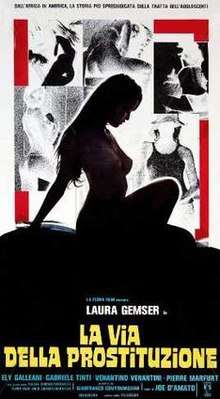Emanuelle and the White Slave Trade
Emanuelle and the White Slave Trade (Italian: La via della prostituzione, lit. 'The path of prostitution') is an Italian sexploitation film from 1978 directed by Joe D'Amato as his last Black Emanuelle film.[2] It was also known as Emanuelle and the Girls of Madame Claude.[3]
| Emanuelle and the White Slave Trade | |
|---|---|
 Theatrical poster | |
| Directed by | Joe D'Amato[1] |
| Produced by | Gianfranco Couyoumdjian[1] |
| Screenplay by |
|
| Story by | Joe D'Amato[1] |
| Starring | Laura Gemser |
| Music by | Nico Fidenco[1] |
| Cinematography | Joe D'Amato[1] |
Production company |
|
Release date | 28 April 1978 (Italy) |
Running time | 88 minutes |
| Country | Italy |
Plot
Emanuelle is in Kenya to arrange an interview with the Italian American gangster George Lagnetti ("Giorgio Rivetti" in the English dub). She succeeds in meeting him with help from her friend Susan Towers and Prince Aurozanni but is intrigued by other events, leading her to meet the white slave trader Francis Harley, and setting her up for a dangerous undercover operation at the San Diego mansion of Madame Claude, which functions as a brothel for top-level dignitaries and civil servants.
Cast
- Laura Gemser ... Emanuelle
- Ely Galleani ... Susan Towers
- Gabriele Tinti ... Francis Harley
- Venantino Venantini ... Giorgio Rivetti
- Pierre Marfurt ... Prince Arausani
- Gota Gobert ... Madame Claude
- Nicola D'Eramo ... Stefan
- Bryan Rostron ... Jim Barnes
Background
Emanuelle and the White Slave Trade features the investigative journalist character known to her readers as 'Emanuelle' (Laura Gemser). Like most films directed or produced by Joe D'Amato, it is an attempt to capitalise on the commercial success of another film - in this case the 1977 film The French Woman (French: Madame Claude). The film is one of the Black Emanuelle films with the heaviest censorship, eight minutes cut in a theatrical release.[4]
Release
Emanuelle and the White Slave Trade was released in Italy on April 20, 1978.[5]
Reception
In a contemporary review, John Pym (Monthly Film Bulletin) "a flimsy, though surprisingly unsensational, yarn supposedly concerned with the horrors of 'white slavery'. The dismal artifice of the whole severely tests the viewer's patience."[1]
References
- Pym, John (1979). "Emanuelle and the White Slave Trade". Monthly Film Bulletin. Vol. 46 no. 540. British Film Institute. p. 130.
- "Emanuelle and the White Slave Trade". The New York Times.
- Amador, María Luisa; Blanco, Jorge Ayala (2006). Cartelera cinematográfica, 1980-1989 (in Spanish). UNAM. p. 137. ISBN 9789703236053. Retrieved 21 February 2019.
- Stracult: Dizionario dei film italiani (2004), Marco Giusti, Frassinelli, Roma, ISBN 8876848134
- Buchanan, Jason. "Via Della Prostituzione". AllMovie. Archived from the original on 6 June 2012. Retrieved 19 August 2017.